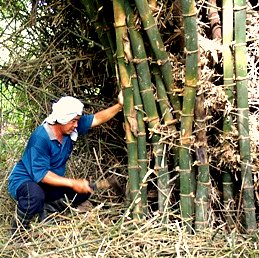Click to read: / Growing Bamboo / Clumping Bamboo Plant Care / Potted Bamboo / Buddha Belly Bamboo /
Learning first the different practices in plant care is a requisite in bamboo production. This is especially important when planning to establish bamboo plantations in commercial scale.
After having been convinced that growing bamboo is financially feasible but before the commencement of the activities in farm development, the next step that an agri-entrepreneur has to do is the preparation of a master plan. In the preparation of such plan, familiarity with the care of bamboo plant is essential.
Although the basics of crop farming apply to bamboo plant care, their application is in general and not specific. Bamboos are unique plants with various properties and growth habit requiring special care. There are tall and dwarf bamboo, erect and climbing bamboo, running and clumping bamboo.
The Following Post-planting Practices in Bamboo Plant Care Are Recommended
1. Watering. Many species of bamboo, particularly the thorny bamboo or kawayan tinik (Bambusa blumeana) can thrive with scant rainfall. For optimum growth, however, sufficient water should be supplied to the bamboo plants especially at seedling stage, in sandy soils, and during drought or dry season.
2. Weeding. The growth of weeds should be suppressed to minimize competition for water, nutrients and light.
3. Mulching. Mulching is the operation which consists of the laying or placing of any material, either organic or inorganic, natural or synthetic, on the ground mainly to minimize loss of water from the soil through evaporation, to suppress weed growth, to control erosion, and to regulate soil temperature.
In bamboo, it should be started immediately after planting by collecting cut foliage, leaves or straws of weeds within the farm and piling these, as compactly as possible, at the bases of the seedlings. The thicker, the better. When decomposed, these will become organic fertilizers.
4. Crop Protection. Bamboo is resistant to insect pests and diseases. Should there be incidence, apply any pesticide. To ensure that the plants will not be injured by astray animals, each should be provided with a tree guard or the whole plantation is fenced. The fence will also exclude intruders who may be tempted to harvest young shoots.
As protection from fire especially during dry months, strips of land can be made into firebreaks by plowing to get rid of combustible vegetation.

5. Fertilizing. Although bamboo plants can survive in poor soils, it is advantageous to apply fertilizer for optimum growth. Fertilizer application at the rate of 200-300 gm per plant starts after planting and every 3-4 months thereafter. As the clumps become thicker, the rate of fertilizer should also be increased progressively. The application of fertilizer can be scheduled at the start and at the end of the rainy season in areas having pronounced dry and rainy seasons.
Organic fertilizers such as compost and manures may also be used in combination with or as a substitute to synthetic fertilizers.
6. Pruning. The lower branches of the culms should be removed to enhance farm visibility, promote air movement and facilitate ease in fertilization and harvesting. Partial pruning of the thorny thicket surrounding the clumps of kawayan tinik is also recommended to allow passage between clumps especially when planted with narrow spacing. Sufficient thicket should be retained to hold the culms erect.
7. Thinning. Thinning or removal of dead, damaged and defective culms is done 3 years after planting. This will promote visibility and provide more space for the growth of new shoots. In large clumps, removal of young shoots with narrow diameter is recommended. These will develop into small culms but will likely become hindrances during harvesting.
8. Roguing. Roguing is the removal of off-types and is an essential part of bamboo plant care in bhudda belly (Bambusa ventricosa). In such species, it is expected that shoots belonging to bayog (Bambusa sp.) will grow within the clump. Left unchecked, bayog will invade the clump and, ultimately, it will consist purely of bayog culms.
To preserve the specific identity of the clump, off-types should be removed immediately. The rhizome from where the off-type culm originated should be removed.
9. Harvesting. Mature culms of desirable sizes are ready for harvest at 3-5 years after planting. Harvesting is preferably done during dry months. The removal of culms will promote the growth of new shoots, in time for the incoming rainy season.
These practices on bamboo plant care are intended for erect, clumping bamboo under tropical conditions.
